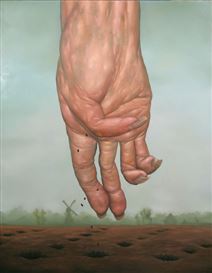Seth Alverson Rules the Group Show at Blaffer
Seth Alverson`s work always amazes me, not only because of his virtuosity as a painter but because of the compelling mystery that lies within. You
Beth Secor / Houston Press
Jul 17, 2008

Alverson`s works are rife with references to the American Sublime, picture postcards and travelogue illustrations from the 1930s, Civil War era newspaper engravings, true crime photos, garish Kodachrome slides from 1950s ladies` magazines and the Surrealist collages of Ernst. His Death and Life in the Alps (2007) presents an appropriately overwhelming view of the mountain range, with two oval-shaped paintings within the painting -- one, of an empty casket, on the lower left side, and the other, of the corner of an empty room, on the lower right. The implication is that a person died, but the body hasn`t made it to the casket yet, presenting a terrible feeling of limbo.
In Alverson`s Untitled, two people have been killed, presumably in the same room in the little insert in the previous painting. One man`s head is blown clean off, and the other lies diagonally sprawled across the floor near the front door -- both are victims of someone or something awful. Inserted above them is an oval view of the housetops of a town, perhaps at dusk. It could represent the time and place the murders were committed, the town the murderer fled to or none of the above.
A diptych by Alverson, Parlor I and Parlor II, shows two near identical views taken in a funeral parlor, with only slight differences in perspective. One shows the lamp, the flowers, the horrible curtains and the left edge of the casket, while the second repeats all elements but with a smaller sliver of the casket in view. It`s as though what`s in the casket is meaningless, and only the trappings matter. In the final painting, the casket stands alone; it`s open, with the pillow slightly disturbed, as though someone were lying there and thought better of it.
Lynn McCabe`s work is also strong, which is kind of a weird comment to make about a Sheetrock wall. According to the Blaffer`s catalogue, McCabe`s installation Building Walls Together "investigates the delicate balance between social integration and artistic exploration in 颅community-oriented practices." Building Walls Together is also a wonderful maneuver of deceit. Lynn, armed with documentary evidence including e-mail correspondence, sham photos of children posed with tools, parental permission slips and contracts, tricks us into thinking that she oversaw a group of child laborers in the construction of a crappily built wall. I looked at the photos, read some of the wall of paperwork, looked at the wall and came to the immediate conclusion that, yes, kids constructed it. But as I later learned, they did not. What surprised me was the beauty of the wall itself, because of -- not despite -- its glopped-up spackling, loony application of drywall tape and cracks. (I wish Nicholas Kersulis, another artist in the show, had absorbed some of Lynn`s aesthetic before placing unsightly screws in the center of his circular panels of paint.)
Sasha Dela`s video Bits and Pieces is a beautifully filmed and edited, often funny, and compelling commentary on consumerism. In the video, car lot attendants, restaurant staff and customers eat food and drink beer, looking directly into the camera and saying variations of "I am hungry," "I want to eat you," "I taste good," "You look so good I could eat you up," and "I want to cut you up into a million pieces and eat you." Mirrors above and below the footage reflect the viewer`s body. The people in the video are not anonymous strangers -- they are us, as reflected in the mirrors, eating, drinking, driving gas-guzzling cars, buying millions of plastic bottles filled with water that we could just as easily get out of the faucet, and, in truth, building up a big, nasty carbon footprint. Even though most of the people in the video have smiles on their faces, they are nervous smiles. This isn`t the fairy tale where we are the good guys and are going to win in the end. Instead, we are the vain dancing girl with no feet who insisted on having those red shoes.
I wasn`t so interested in Hedwige Jacobs`s animation, but loved most of her drawings of swimming pools, basket weave houses, cul de sacs and what look like headless "American Girl" Shivas. Jacobs effectively uses negative space and has a deliberateness and economy of line that reminds me of the late Bill Traylor. I was actually shocked when I noticed an erasure mark on Open Pool, since I`d imagined she was one of those fortunate people who work out mistakes in their heads before ever touching pen or pencil to paper. Another artist, Deborah Grant, whose work was recently seen in "Old Weird America" at the CAMH, deliberately appropriates Traylor`s work, but she doesn`t understand its vernacular. This is not the case with Jacobs, whether or not she is familiar with Traylor`s 颅masterpieces.
There are some works in the show that slightly miss the mark. Hana Hillerova`s steel-and-mirror pieces look like the display cases at the Diamondesque Jewelers in the town square of a small southeast Texas town, five minutes after the store was burglarized. Although the catalogue says these sculptures are "precisely cut, glued and threaded strips of mirror," I saw cracked corners and joints and kept expecting the residual strings of glue you get when you use a glue gun. Jonathan Durham`s Head High and Glassy is slightly flawed by the overuse of epoxy -- it would have been so much lovelier if the tobacco leaves had been exposed, but considering how brittle they become, that probably wasn`t feasible.
I also wish Ariane Roesche`s Zusammenbruch (breakdown) were actually reflective of its title. This installation consists of truncated black-and-white silkscreen images of people, from the `50s or early `60s, all involved in some sort of communicative act -- talking to one another, talking on the phone -- and connected to one another by wiring or tubing that runs around the room and terminates in a fax machine. The tubing runs neatly in nice, orderly horizontal or vertical lines, and the majority of the figures are interspersed at floor level throughout the room. What I really wish is that Zusammenbruch were loud and messy and out of control, and that the nice, neat lines of communication had truly broken down.
And while I am wishing, I wish I had seen Jeff Williams`s work. I have seen examples of it in the past, and it often consists of a common household item, such as a floor fan full of dust. According to the show`s catalogue, "Williams draws our attention to what is usually hidden out of sight." Actually, I think I might have seen his installation at the gallery, but rather than mentally register it as part of the show, I instead thought, "Damn, Blaffer really needs to get somebody in here to clean the place."
Despite the uneven quality of some of the work, the show is certainly worth seeing. Claudia Schmuckli`s decision to pare down the number of artists and let them show larger installations and bodies of work was a wise one.
COPYRIGHT: Copyright NT Media, LLC Jul 17, 2008. Provided by Proquest- CSA, LLC. All Rights Reserved. Only fair use as provided by the United States copyright law is permitted.
PROQUEST-CSA, LLC- MAKES NO WARRANTY REGARDING THE ACCURACY, COMPLETENESS, OR TIMELINESS OF THE LICENSED MATERIALS OR ANY WARRANTY, EXPRESS OR IMPLIED.













